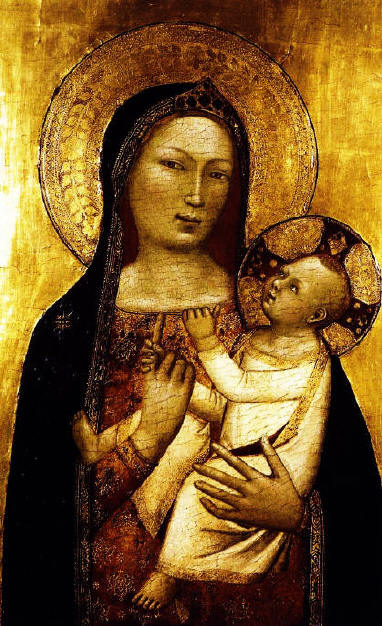Popular Questions About Renaissance Art
History
What is the difference
between Italian Renaissance art and Northern Renaissance art?
How did the Black
Death impact European art history?
How did the Inquisition
impact European art history?
What was the
influence of the Medici
Academy on Renaissance painters?
What was the
Bonfire of the Vanities?
Who were the greatest
painters of the Renaissance?
Search:: Artists Alphabetically Artists by Country Artists by Century Artists by Movement
| Painting in the
Medieval Age The Church was the all powerful institution of the Medieval, and commissioned thousands of Biblically themed art-works such as paintings, sculptures, architecture and illuminated manuscripts. According to historian, Hendrik van Loon, "To the man and woman of the thirteenth century, the world hereafter–a Heaven of wonderful delights and a Hell of brimstone and suffering–meant something more than empty words or vague theological phrases. It was an actual fact and the mediaeval burghers and knights spent the greater part of their time preparing for it." Stories of the Bible were told and retold continuously--painted, sermonized, allegorized, embellished, creating a convincing and mysterious faith.  With the triumph of Christianity, Medieval artists aspired to reawaken the divine spirit of holy figures rather than depict their physical qualities. Their unique style is a combination of frontal simplicity, decorativeness, prismatic coloration, and harmonious unity. The use of costly materials such as gold, precious stones and ivory indicates the degree of wealth that was common during this period, and attests to the sophistication of the affluent class. Art of the Medieval period, 550-1450, is highly elaborate and intriguing, weighed down with piety and overflowing with symbolism. Narrative paintings, with their layer upon layer of symbolism were used by the clergy as spiritual guidebooks as well as stern warnings of the fiery hell that waited backsliders. The greatest painter of the Medieval period was Florentine master Giotto. Giotto, celebrated as architect, painter and sculptor, had a feeling for what was beautiful as well as a knowledge of what was sacred. He introduced color as a distinct element into Medieval Italian painting. His composition was always distinctly graceful. Painters from the middle ages had a taste for the profound and their use of symbols are mysterious hints and glances into the shadowy religious world that lay behind the grinding reality of the times. A ripe apple, a peach, a golden pear, a lemon, a luscious strawberry, an pomegranate—all are charmingly decorative to the average viewer. For painters of the Medieval period, symbols were part of a rich visual language. In a culture of restricted literacy symbolic imagery was vital in helping to spiritually enlighten the rabble and keep them on the path to heaven. The Church commissioned artisans and craftspeople to create religious imagery for churches and state building. These sacred images gave spiritual comfort to illiterate serfs and served as a constant reminder of the hellish tortures that awaited backsliders and sinners if they strayed from Gods word and church law. In a society of almost complete illiteracy, constant outbreaks of plague, smallpox, leprosy, and the ever present threat of starvation, the beauty of art and architecture was a true haven. Paintings were grave and deep, infused with an ethereal emotional intensity. The mysticism of the Medieval period imparts a sense of uniqueness and sensuous charm to artworks. Medieval style represented Christian culture and values as well as courtly splendor. Most prominently featured are the holy symbols of the Christian faith--Christ, Saints, The Cross, Virgin Mary, Chalice, Keys, The Anchor, Wheat , Animals, Fish,Angels, Birds, Insects and Satan and his minions. |
If you feel you have worthwhile information you would like to contribute we would love to hear from you. We collect proverbs and old sayings from folks all over the globe and appreciate your participation. When submitting please, if possible, site the source and provide English translation. Email to historyofpainter@gmail.com
© HistoryofPainters.com 2017
If you like this page and wish to share it, you are welcome to link to it, with our thanks.
